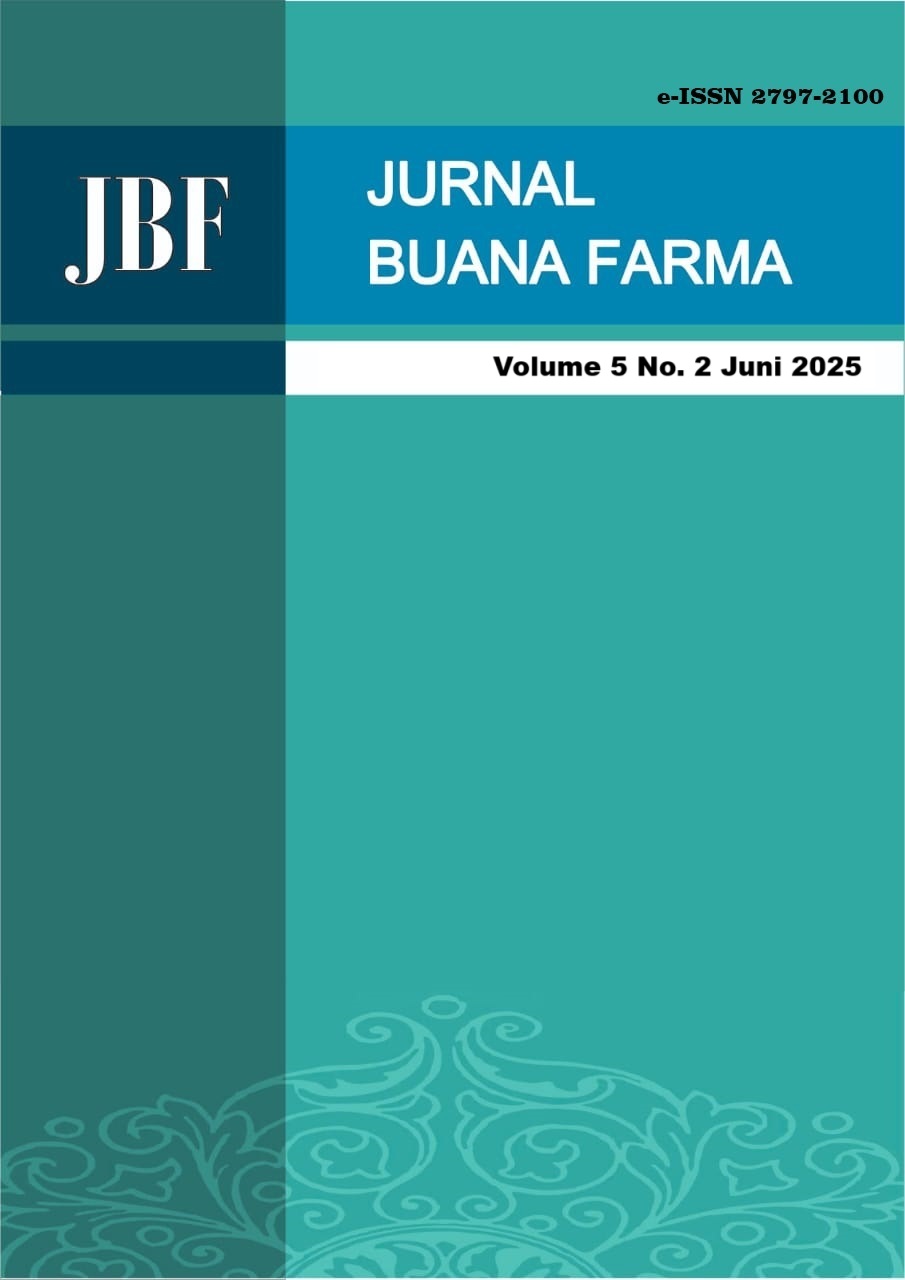POTENSI ANTIINFLAMASI SENYAWA BIOAKTIF DARI SYZYGIUM MYRTIFOLIUM: STUDI MOLECULAR DOCKING BERTARGET COX-2
Abstrak
Peradangan kronis berkontribusi besar terhadap berbagai penyakit degeneratif, dan Cyclooxygenase-2 (COX-2) merupakan target utama dalam pengembangan terapi antiinflamasi. Syzygium myrtifolium, tanaman asli Indonesia, diketahui mengandung beragam senyawa bioaktif dengan potensi farmakologis. Penelitian ini bertujuan untuk mengeksplorasi aktivitas antiinflamasi senyawa aktif S. myrtifolium terhadap COX-2 melalui pendekatan molecular docking. Senyawa yang diteliti antara lain avikularin, asam betulinat, asam ursolat, serta dua flavanon yang dimodelkan dan di-docking terhadap protein COX-2 (PDB ID: 5F19). Proses docking dilakukan menggunakan perangkat lunak YASARA dengan metode blind docking, dan hasil divisualisasikan menggunakan Discovery Studio. Hasil menunjukkan bahwa empat senyawa memiliki nilai energi ikat lebih tinggi dibandingkan celecoxib sebagai kontrol, dengan senyawa (2S)-7-Hydroxy-5-methoxy-6,8-dimethylflavanone menunjukkan interaksi paling stabil memiliki nilai energi ikat 9.0450 kkal/mol. Prediksi toksisitas menunjukkan bahwa senyawa-senyawa tersebut tergolong aman berdasarkan parameter LD50 dan kelas toksisitas. Temuan ini memberikan dasar yang kuat untuk pengembangan senyawa alami sebagai inhibitor COX-2 potensial.
Referensi
Amanah, D., Manalu, R. T., Sholikha, M., Syafriana, V., & Yasman, Y. (2023). Molecular Docking of Active Compounds of Syzygium myrtifolium Walp. Leaves on Leukotriene A4 Hydrolase Receptors as Colorectal Anticancer. Jurnal Kimia Sains Dan Aplikasi, 26(5), 194–203. https://doi.org/10.14710/jksa.26.5.194-203
Araújo, P. H. F., Ramos, R. S., da Cruz, J. N., Silva, S. G., Ferreira, E. F. B., de Lima, L. R., Macêdo, W. J. C., Espejo-Román, J. M., Campos, J. M., & Santos, C. B. R. (2020). Identification of potential COX-2 inhibitors for the treatment of inflammatory diseases using molecular modeling approaches. Molecules, 25(18). https://doi.org/10.3390/molecules25184183
Bäck, M., Yurdagul, A., Tabas, I., Öörni, K., & Kovanen, P. T. (2019). Inflammation and its resolution in atherosclerosis: mediators and therapeutic opportunities. In Nature Reviews Cardiology (Vol. 16, Issue 7, pp. 389–406). Nature Publishing Group. https://doi.org/10.1038/s41569-019-0169-2
Deng, Z., & Liu, S. (2021). Inflammation-responsive delivery systems for the treatment of chronic inflammatory diseases. Drug Delivery and Translational Research, 11(4), 1475–1497. https://doi.org/10.1007/s13346-021-00977-8
Hawash, M., Jaradat, N., Sabobeh, R., Abualhasan, M., & Qaoud, M. T. (2023). New Thiazole Carboxamide Derivatives as COX Inhibitors: Design, Synthesis, Anticancer Screening, In Silico Molecular Docking, and ADME Profile Studies. ACS Omega, 8(32), 29512–29526. https://doi.org/10.1021/acsomega.3c03256
Jena, S., Ray, A., Sahoo, A., Das, P. K., Dash, K. T., Kar, S. K., Nayak, S., & Panda, P. C. (2021). Chemical Composition and Biological Activities of Leaf Essential Oil of Syzygium myrtifolium from Eastern India. Journal of Essential Oil-Bearing Plants, 24(3), 582–595. https://doi.org/10.1080/0972060X.2021.1947897
Krewski, D., Acosta, D., Andersen, M., Anderson, H., Bailar, J. C., Boekelheide, K., Brent, R., Charnley, G., Cheung, V. G., Green, S., Kelsey, K. T., Kerkvliet, N. I., Li, A. A., McCray, L., Meyer, O., Patterson, R. D., Pennie, W., Scala, R. A., Solomon, G. M., … Zeise, L. (2010). Toxicity testing in the 21st century: A vision and a strategy. In Journal of Toxicology and Environmental Health - Part B: Critical Reviews (Vol. 13, Issues 2–4, pp. 51–138). https://doi.org/10.1080/10937404.2010.483176
Lucido, M. J., Orlando, B. J., Vecchio, A. J., & Malkowski, M. G. (2016). Crystal Structure of Aspirin-Acetylated Human Cyclooxygenase-2: Insight into the Formation of Products with Reversed Stereochemistry. Biochemistry, 55(8), 1226–1238. https://doi.org/10.1021/acs.biochem.5b01378
Mariska, S., Zaki, M., Rahmadi, A., Hanifa, M., Hasna, R., Azara, S., Irawan, N., Putri, R. A., & Saputra, M. Y. (2024). Antibacterial Potency of Bioactive Compounds from Areca catechu Nuts: A Molecular Docking Study Targeting 8H1B. Helium: Journal of Science and Applied Chemistry, 04, 13–18. https://journal.unpak.ac.id/index.php/he_jsac
Oktaviani, N. P. S., Ivansyah, A. L., Saputra, M. Y., Handayani, N., Fadylla, N., & Wahyuningrum, D. (2023). Potential application of bisoprolol derivative compounds as antihypertensive drugs: Synthesis and in silico study. Royal Society Open Science, 10(12). https://doi.org/10.1098/rsos.231112
Peregrym, K., Szczukowski, Ł., Wiatrak, B., Potyrak, K., Czyżnikowska, Ż., & Świątek, P. (2021). In vitro and in silico evaluation of new 1,3,4-oxadiazole derivatives of pyrrolo[3,4-d]pyridazinone as promising cyclooxygenase inhibitors. International Journal of Molecular Sciences, 22(17). https://doi.org/10.3390/ijms22179130
Shifeng, P., Boopathi, V., Murugesan, M., Mathiyalagan, R., Ahn, J. C., Xiaolin, C., Yang, D. U., Kwak, G. Y., Kong, B. M., Yang, D. C., Kang, S. C., & Hao, Z. (2022). Molecular Docking and Dynamics Simulation Studies of Ginsenosides with SARS-CoV-2 Host and Viral Entry Protein Targets. Natural Product Communications, 17(11). https://doi.org/10.1177/1934578X221134331













